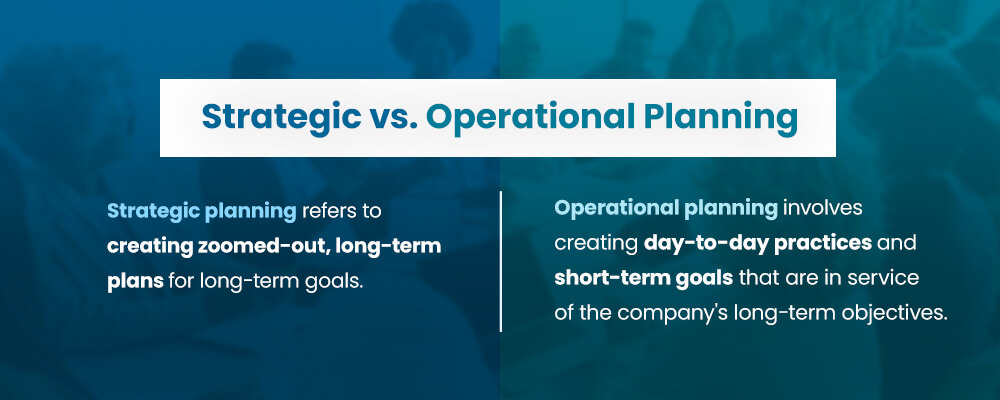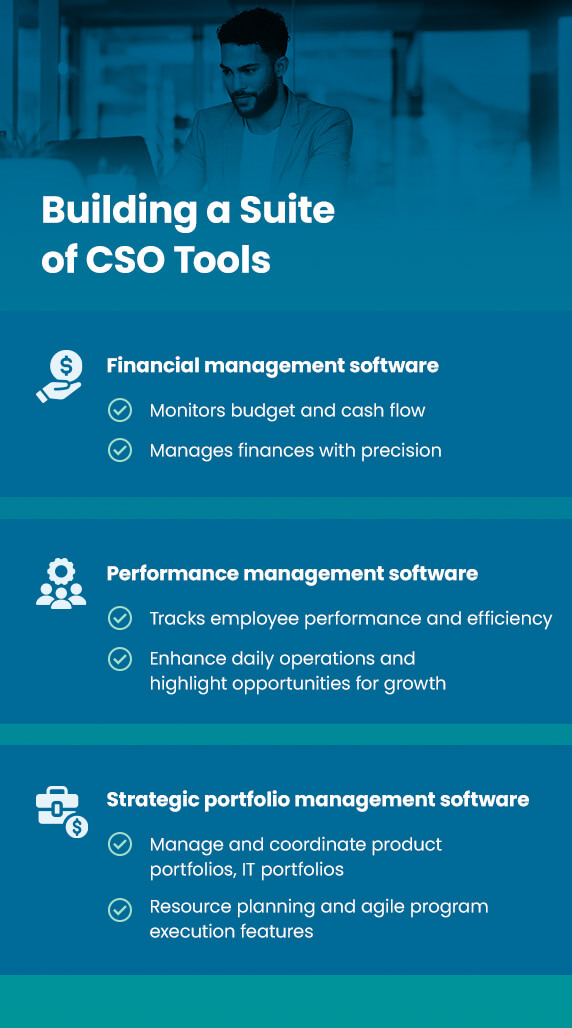Planning and budgeting are vital to your organization’s strategic operations, and when they work together, they can transform your marketplace performance. Chief strategy officers (CSOs) are often at the forefront of this integration. They are responsible for formulating a coherent corporate strategy and coordinating with stakeholders to ensure effective execution. Clear communication, detailed financial data and advanced chief strategy officer tools are all vital to this endeavor.
CSO tools are especially useful for integrating all aspects of your corporate strategy. These systems facilitate budgeting, strategic planning and operational planning. They include financial management software, performance management solutions, and enterprise strategy execution platforms. Each one provides deep value for companies and can be integrated with the others to enhance all aspects of planning.
Learn more about these tools and how you can integrate planning and budgeting to help your organization reach its goals.
In This Article
- The Role of the Chief Strategy Officer
- Strategic vs. Operational Planning
- The Role of Budgeting in Strategic Execution
- Enterprise Strategy Execution Platforms
- Building a Suite of CSO Tools
- CSO Tools vs. Project Management Tools
- Best Practices for Strategic Alignment, Governance and Visibility
- Overcoming Common Integration Challenges
The Role of the Chief Strategy Officer
The CSO is one of the highest-ranking positions within the corporate structure. In the course of their duties, they:
- Report to the chief executive officer (CEO).
- Leverage technology and experience to analyze the marketplace and the organization’s internal finances and performance.
- Identify issues facing the organization.
- Identify short- and long-term business objectives.
- Assess and budget money and resources to ensure that objectives are practically achievable.
- Develop a corporate vision to achieve those objectives.
- Oversee strategic planning and ensure it aligns with organizational objectives.
- Manage strategic initiatives and rollouts across the organization.
- Collaborate with stakeholders of all levels to enhance operational execution.
- Handle mergers, acquisitions, partnerships, joint ventures and organizational collaborations.
- Review and adjust corporate strategy in light of new data.
Visibility, control and governance in strategic planning must be emphasized throughout each aspect of the CSO’s duties. Every stakeholder within the organization should have a clear sense of the organization’s goals and how they are being achieved. They should have complete confidence in both CSO’s decision-making and their ability to lead mid- and high-level management in pursuing the organization’s goals. If they don’t, the organization’s strategy may fail to yield positive results.

Strategic vs. Operational Planning
Planning within an organization can be divided into strategic and operational. The two are separate but intimately connected.
Strategic planning refers to creating zoomed-out, long-term plans for long-term goals. This is the realm of the CSO and often involves working with data-driven projections, organization-wide initiatives, financial management software and enterprise strategy execution platforms.
Strategic planning is wide in scope and focused on the future. It is primarily driven by upper-level management, who are responsible for setting goals and deciding where the organization is headed and how its resources will be used.
Operational planning involves creating day-to-day practices and short-term goals that are in service of the organization’s long-term objectives. Typically, this level of planning is handled by middle management and key decision-makers on the ground. An enterprise strategy execution platform will likely be integrated for all stakeholders within operational planning, but middle management will also rely on industry best practices, department-wide feedback and communications with superiors to determine how things should be done.
Operational planning is focused on the day-to-day and week-to-week operations within the organization that help it achieve its long-term goals. It is deeply rooted in the present, and everyone within the organization is directly and immediately impacted by the effects of operational planning.
Operational planning itself is also directly affected by strategic planning, and when the two work together, your organization has vertical alignment. When all departments work together toward operational objectives, your organization has horizontal alignment. Maintaining alignment across these two dimensions will increase unity and help your organization move toward its goals faster.
The Role of Budgeting in Strategic Execution
Budgeting is the third corner of the organizational planning triangle. Generally, chief financial officers (CFOs) are responsible for managing the budget, and CSOs are responsible for collaborating with them to gain a clear sense of the organization’s position and resources. This collaboration is necessary for effective strategic execution, as your organization can only act within the confines of its resources.
Within strategic planning, your organization’s budget will impact:
- The amount of money that can be invested in marketing campaigns, research and development, and new technologies.
- Expansion to new locations and industries.
- The ability to meet its employees’ needs and retain talent in the coming fiscal quarter and year.
- Reach within the market and its community at large.
- Adopting new technologies and educating employees on using them effectively.
Within operational planning, your organization’s budget will impact:
- The daily practices your organization relies on to produce value, such as manufacturing processes or international logistics.
- The technology that your organization invests in.
- The number of employees it can retain or hire.
- The quality of equipment that is used daily.
- The service providers you work with, such as overseas circuit board fabricators or local construction companies.
Enterprise Strategy Execution Platforms
When it comes to aligning strategic and operational planning, few tools are as useful as enterprise strategy execution platforms. This technology facilitates both aspects of planning by allowing you to align tasks and goals across every level of the organization. From there, you and other users can zoom in and out as necessary to manage daily tasks, track performance and keep your organization aligned with its short- and long-term goals.
Some companies choose to leverage a CSO technology stack to build their own enterprise strategy execution platform and tailor it to their exact preferences. While this process may take time, it also gives your organization direct control over every aspect of the interface and software. Other CSO technology stack benefits include the ability to update the platform on your own timetable and keep all organizational data in-house.
For many companies, the best option is to partner with an existing enterprise strategy execution platform. Doing so gives your organization immediate access to the platform and saves you the time and money spent on research and development.
The key features of these platforms include:
- Real-time custom dashboards: The central hub of the platform is the dashboard, which can be customized to focus on the most important information, goals and tasks. Many of these platforms even provide real-time updates for all the information in the display, allowing CSOs to keep tabs on both the big and the small picture as they happen. You can then zoom into topics attached to the dashboard with the click of a single button, making your organization’s most important data and goals easy to access and manage.
- Key performance indicator (KPI) alignment: Your key performance indicators track your organization’s health and can vary based on your goals. Some companies choose to focus on revenue growth, while others are more keyed into production output. Whatever KPIs you value, you can track them within the enterprise strategy execution platform and ensure your goals and tasks are all working to improve these KPIs.
- Cross-functional execution: The platform unites disparate departments within a shared interface, allowing for enhanced coordination and communication. Human resources teams can plan and execute new organization-wide initiatives with the direct digital support of management, for instance. This interconnectivity not only increases organizational agility and unity but also improves morale, as teams are able to interact on a more consistent and supportive basis.
- Strategic governance tools: Any enterprise strategy execution platform worth its salt will include tools that allow CSOs and other high-level stakeholders to protect data and limit who is able to access and alter it. This way, sensitive data stays secure from outside tampering. KPIs, tasks and goals will also remain consistent across departments.
Building a Suite of CSO Tools
While an enterprise strategy execution platform is among the most important digital tools a CSO can have at their disposal, there are many systems that can support it — and your organization’s corporate strategy as a whole. Many are even designed to interface with one another, so it’s important to keep an eye out for compatible tools or even a complete suite of CSO tools designed to work in unison.
Some of the most important CSO tools include:

- Financial management software: From budgeting to cash flow monitoring, financial management software equips your organization to monitor and manage its finances with precision. Use it to track and organize income and expenses. You can even use existing data to create projections of your organization’s future performance. Managing payroll and incoming and outgoing payments is also made far easier by financial management software. The insights generated by these features directly impact strategic and operational planning.
- Performance management software: Tracking employee performance and efficiency is made simple by this software. With its goal tracking, performance review and feedback collection features, it is able to enhance daily operations and highlight opportunities for growth. Performance management software is especially useful for operational planning. The insights provided by the software should inform daily practices across the organization, and it may even highlight opportunities for drastic change and process optimization.
- Strategic portfolio management software: Product portfolios, IT portfolios and more can all be managed and coordinated within this software. Operational planning especially benefits from this coordination. Resource planning and agile program execution can increase your organization’s control over its assets while increasing its ability to respond to changes in the market and in the world at large. Other strategic portfolio management software features include strategic roadmaps, node visualizations and advanced reporting analytics.
CSO Tools vs. Project Management Tools
The CSO tools outlined above are distinct from project management tools. The key difference is scale. Where project management tools, such as Monday or Asana, focus on organizing and tracking day-to-day operations, CSO tools focus on the bigger picture. Their job is to collect, track and analyze the data provided by your organization’s daily processes and general direction to allow for effective long-term decision-making. For the CSO, trends, numbers and data-based projections are most important. Project management tools are not designed to analyze these at scale.
That said, project management tools should not be taken for granted. They represent an important link in the chain connecting operational and strategic planning. The workforce data provided by project management tools can, for instance, be leveraged by CSO tools to reveal opportunities for enhanced efficiency and organizational change. Many of the features of strategic portfolio management software also benefit from the data provided by project management tools.
In some cases, you may encounter project management tools that are specifically designed to integrate with the suite of software CSOs rely on. That compatibility makes it far easier to synchronize and coordinate operational and strategic planning with one another.
Best Practices for Strategic Alignment, Governance and Visibility
Planning and executing corporate strategy takes more than just top-down control. It requires real coordination and understanding across all levels of the organization, and fostering both starts with effective strategic alignment, governance and visibility.

When it comes to strategic alignment, integrating your organization’s enterprise strategy execution platform with its project management tools is the best place to start. Many platforms have companion tools that serve this exact purpose, while others will need to be manually integrated. Doing so allows your strategic planning to flow directly into operational planning, increasing organizational agility and alignment from top to bottom.
Maintaining control in strategic planning is simpler, as most CSO software and project management programs include governance tools. You can leverage these tools to control who has access to specific platform features and data. Many organizations use them to protect sensitive information and keep other data consistent across the platforms they utilize.
Building visibility in strategic planning is a bit more difficult, as it cannot be created with the push of a few buttons. Integrating strategic and operational planning via your organization’s various platforms tangibly supports this objective. Naming goals and connecting them directly to employee tasks lends those tasks context and purpose. Explicitly communicating the organization’s long-term goals via mission statements, workshops, conferences and email communications is another great way to increase visibility.
Overcoming Common Integration Challenges
Integrating strategic and operational planning is not a seamless process. Some common challenges include:
- Data silos: It’s easy for organizational data to get isolated within specific systems that don’t integrate seamlessly with others. Failing to retrieve it can lead to poorly informed decision-making and inefficient organizational processes, so it is vital to free data from these silos by using compatible platforms.
- Outdated tools: Busting data silos and integrating budgeting with planning is often made harder by outdated tools. They are often incompatible with new systems and lack the high-powered features that new ones offer, such as data-driven projections and chatbot integration. In many cases, the only solution is to invest in new planning solutions that are compatible with your organization’s software suite. Such an investment can enhance both planning and budgeting while making work simpler and faster for everyone.
- Learning curves: New platforms and features always take time to adjust to. Your organization can speed up that process by creating and disseminating guides and training for new features and the system as a whole. Many platforms also offer their own tutorials to get new users up to speed.
Partner With AchieveIt Today

If you’re looking for integrated plan management, AchieveIt is the solution. Strategic and operational planning are made easy when you don’t have to go anywhere to do them. Our strategy software supports plan creation, plan management, process management and performance assessment, all in one place. For over a decade, it has been transforming strategy for companies around the globe, and yours could be next.
To learn more, schedule a strategy demo or give us a call at 844-431-7165 today.



